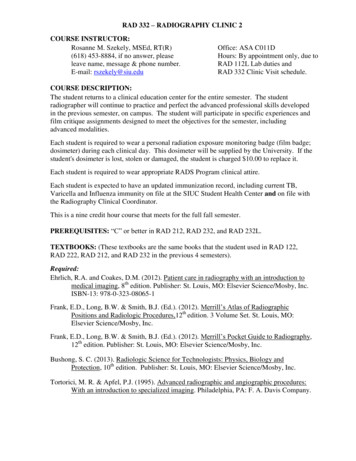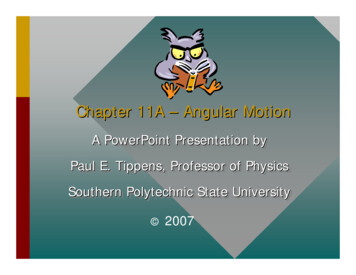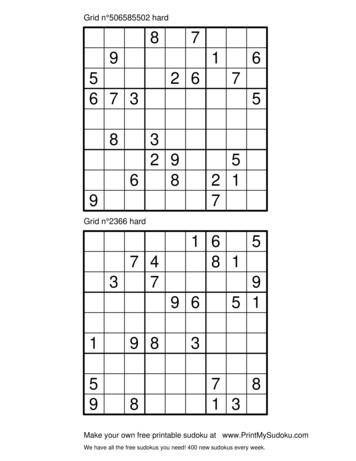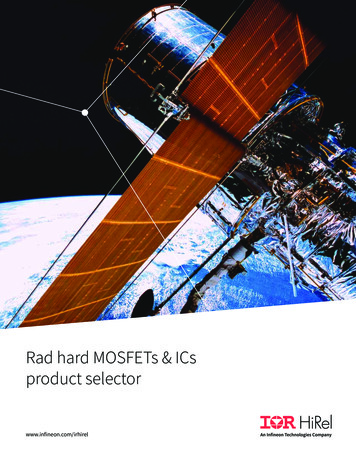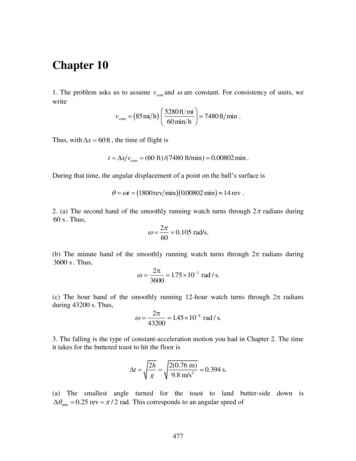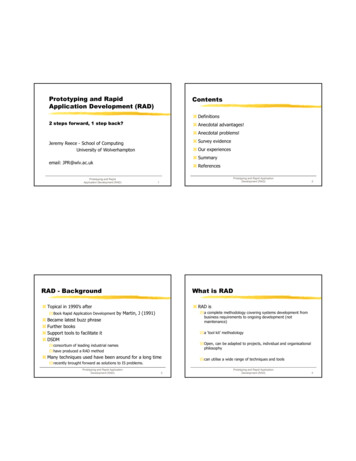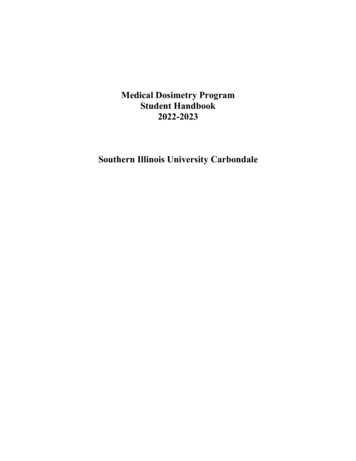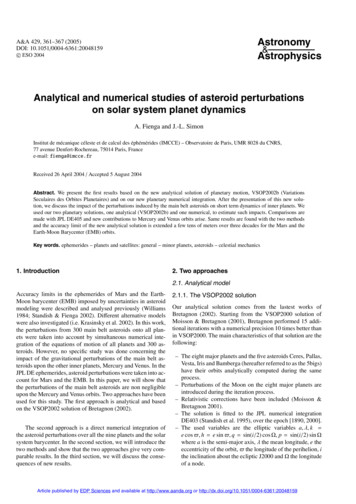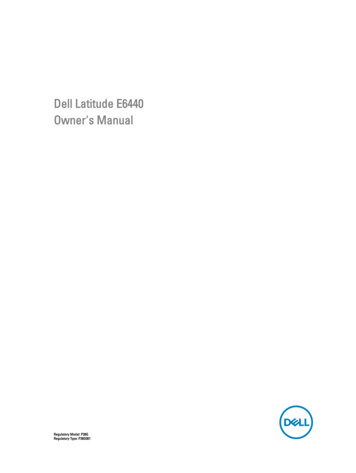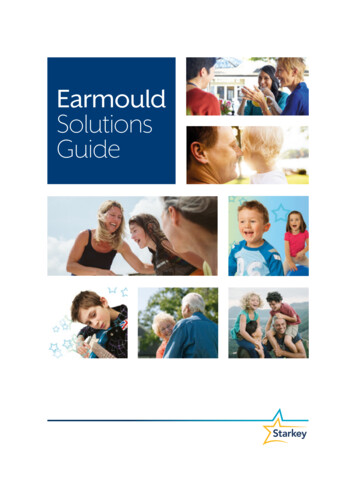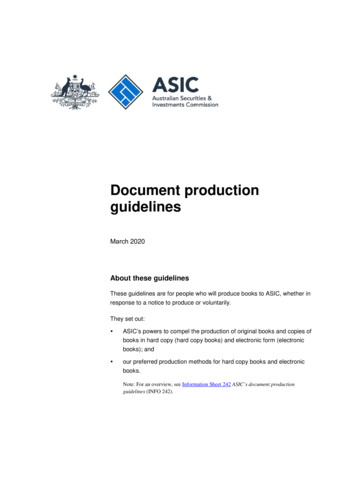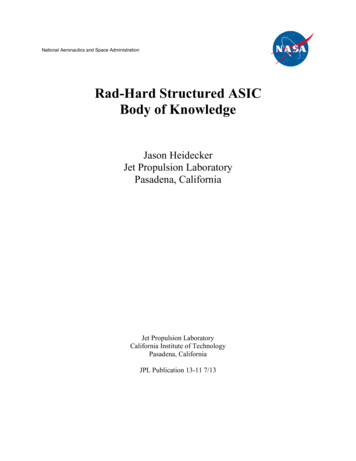
Transcription
National Aeronautics and Space AdministrationRad-Hard Structured ASICBody of KnowledgeJason HeideckerJet Propulsion LaboratoryPasadena, CaliforniaJet Propulsion LaboratoryCalifornia Institute of TechnologyPasadena, CaliforniaJPL Publication 13-11 7/13
National Aeronautics and Space AdministrationRad-Hard Structured ASICBody of KnowledgeNASA Electronic Parts and Packaging (NEPP) ProgramOffice of Safety and Mission AssuranceJason HeideckerJet Propulsion LaboratoryPasadena, CaliforniaNASA WBS: 104593JPL Project Number: 104593Task Number: 40.49.01.12Jet Propulsion Laboratory4800 Oak Grove DrivePasadena, CA 91109http://nepp.nasa.govi
This research was carried out at the Jet Propulsion Laboratory, California Institute of Technology, and wassponsored by the National Aeronautics and Space Administration Electronic Parts and Packaging (NEPP) Program.Reference herein to any specific commercial product, process, or service by trade name, trademark, manufacturer, orotherwise, does not constitute or imply its endorsement by the United States Government or the Jet PropulsionLaboratory, California Institute of Technology. 2013. California Institute of Technology. Government sponsorship acknowledged.ii
TABLE OF CONTENTS1.0 Introduction . 12.0 Sandia National Laboratories: ViArray . 22.1.1 Performance Specs and Radiation Characterization . 22.1.2 Flight Heritage . 32.1.3 Design Tools . 32.1.4 Design Security . 42.1.5 Contact . 43.0 Honeywell: HX5000. 53.1.1 Performance Specs and Radiation Characterization . 53.1.2 Flight Heritage . 53.1.3 Design Tools . 53.1.4 Design Security . 63.1.5 Contact . 64.0 Triad: VCA . 74.1.1 Performance Specs and Radiation Characterization . 74.1.2 Flight Heritage . 74.1.3 Design Tools . 74.1.4 Design Security . 84.1.5 Contact . 85.0 Aeroflex . 96.0 Conclusion . 107.0 References . 11iii
1.0INTRODUCTIONStructured Application-Specific Integrated Circuit (ASIC) technology is a platform between traditionalASICs and Field-Programmable Gate Arrays (FPGA). The motivation behind structured ASICs is tocombine the low non-recurring engineering costs (NRE) costs of FPGAs with the high performance ofASICs.FPGA technology is designed and fabricated in a process that is completely independent of end-userapplications. It is a “one size fits all” approach to providing a programmable circuit that can support manyapplications. Because the customer has no involvement in FPGA development, there is no NRE cost tothe customer. Moreover, because FPGAs are programmable (and some reprogrammable) by the end-user,FPGAs offer maximum flexibility in terms of programming, debugging, and prototyping. However, therouting complexity required to facilitate this flexibility comes at a large price in terms of the speed andperformance achievable with an FPGA.ASICs, on the other hand, are designed and developed with the end user’s application fully in mind. TheASIC is built to support only a single application, and is therefore a one-off development activity for themanufacturer. NRE costs are very high, as entirely new mask sets must be developed to support just asingle customer’s needs. In contrast, with the FPGA, every chip is identical. However, because back-enddevelopment of an ASIC is done with a single customer’s application in mind, much higher speed andperformance is achievable, as routing can be fully optimized for the customer’s specific application.Structured ASICs aim to offer an intermediate solution. Structured ASICs have essentially the samestructure as an FPGA, but they are mask-programmable instead of field-programmable. Themanufacturer, therefore, goes through a single design and development activity to produce a structuredASIC platform, then finalizes the chip for each customer through a relatively simple programming step atthe end. It follows that some interaction between the manufacturer and customer is required to producethe final circuit, which means more NRE than an FPGA but much less than an ASIC. Structured ASICprogramming involves actual fabrication process steps that configure via layers between metal layers toproduce the desired circuit. The routing complexity needed is much less than what is required for fullfield-programmability, so much greater speeds and performance are possible.This report provides an overview of the structured ASIC platforms that are radiation-hardened andintended for space application.1
2.0SANDIA NATIONAL LABORATORIES: VIARRAYSandia’s structured ASIC product line, known as “ViArray,” debuted in 2005 with the VA260 digitalplatform. The ViArray process was originally developed for nuclear weapon applications in a harshradiation environment, making it ideal for space applications. The VA260 was implemented in Sandia’s0.35 μm radiation-hardened SOI CMOS, 3.3 V technology. The platform offered 260K logic gates,354 Kb of SRAM, 352 Kb of ROM, an on-chip oscillator, and 170 configurable I/Os.Figure 2.0-1. Sample chips of Sandia’s Eiger (digital) and Whistler (mixed-signal) structured ASIC platforms [1].The ViArray product line quickly moved away from VA260 in 2007 with the announcement of the Eiger(digital) and Whistler (mixed-signal, 2009) platforms (see Figure 2.0-1). The baseline process behindthese platforms is also the radiation-hardened 3.3 V, 0.35 μm SOI CMOS. It has advanced significantlysince the VA260 days and now supports 24 mask levels, SOI substrate, STI hardened field oxide, nitridetrench capacitors, LDD implants, 7 nm tunnel oxide thickness, poly SEU transistors, titanium silicide,tungsten via fills, metal/metal capacitors, and LEFF of 0.28 μm (VT 0.7 V and 1.0 V).In addition to the Eiger and Whistler platforms, Sandia also offers ViArray embedded in custom ASICs.Beginning in 2012, 3D-ViArray (stacked chips) went into development to bring more performance in asmaller package/footprint. So far, all ViArray chips have been in plastic BGA packages. However, Sandiahas started development on ceramic column grid arrays, flip-chip PBGA, and flip-chip on-boardtechnologies.2.1.1 Performance Specs and Radiation CharacterizationA comparison of the Eiger and Whistler platforms, including radiation performance, is given inTable 2.1.1-1.Table 2.1.1-1. Sandia Rad-Hard Structured ASIC Platforms.ProcessVDDOperating TemperatureASIC gate-equivalentDual-Port SRAMConfigurable ROMVolatile MemoryOscillatorsPhase Lock LoopsEiger Digital Rad-Hard ViArray0.35 μm SOI CMOS3.3 V 55 C to 125 C276K368 Kb384 Kb2 Kb442Whistler Mixed-Signal Rad-Hard ViArray0.35 μm SOI CMOS3.3 V 55 C to 125 C138K184 Kb192 Kb–22
Power Supply MonitorsPower PartitionsConfigurable I/OsLVDS I/OsBandgap ReferencesChopper Bandgap/BiasHigh Side Current MonitorsLow-Speed A-D ConvertersPipeline A-D ConvertersD-A Converters, 8-bitMultiplexers, 32:1Temperature SensorsComparatorsAmplifiersAnalog SwitchesAnalog Transient RecorderPackageTIDSELQML Status2.1.2Eiger Digital Rad-Hard ViArray442398 Pairs––––––––––––400-pin Plastic Land-Grid Array, 27 27 mm 1 Mrad (Si)ImmuneNoneWhistler Mixed-Signal Rad-Hard ViArray442398 Pairs4254488264481281400-pin Plastic Land-Grid Array, 27 27 mm 1 Mrad (Si)ImmuneNoneFlight HeritageNASA JPL/Caltech and Sandia worked closely together while the ViArray platform was a candidate toprovide rad-hard integrated circuits for the Europa Jupiter System Mission (EJSM) before the project wascanceled [2].Currently, NASA Goddard is building a prototype proof of concept system-on-a-chip utilizing theWhistler platform [2].2.1.3Design ToolsThe ViArray design flow is based on standard ASIC design tools, but heavily augmented with Sandiaproduced intellectual property and scripts to automate recurring design tasks that are specific to theViArray platforms. A list of the electronic design automation (EDA) tools used in ViArray design isgiven in Table 2.1.3-1.Table 2.1.3-1. ViArray Design Tools.Design StepDesign ToolRTL/gate-level simulationMentor ModelSimMixed-signal spice/RTL simulation (optional)Cadence AMSPad-frame generation, vector generation, testbench generation,ASIC tester definitionsSandia scriptsLogic synthesis, scan insertion, STA, ATPGSynopsys toolsAuto Place & RouteViASIC ViaPathParasitic extraction, power analysis, LVS, DRC, mask generation3Cadence & Mentor tools
2.1.4Design SecurityFPGAs have a distinct advantage over ASICs (and structured ASICs) in terms of design security. SinceFPGAs are field-programmable by the end-user, the application design does not need to be shared with athird party (the manufacturer). However, by using a trusted vendor, security risks can be mitigated.Sandia is a DoD Category 1A Accredited Supplier of both “trusted design and foundry services” with ISO9001 certified process optimized for custom radiation-hardened, digital, analog, and mixed-signal ASICs.2.1.5ContactMichael HolmesManager – Mixed Signal ASIC/SoC ProductsSandia National Laboratories1515 Eubank Blvd. SEMS-1072Albuquerque, NM 87123Office: 505-284-96734
3.0HONEYWELL: HX5000The HX5000 standard cell, structured ASIC platform went into production in 2007 and received QMLClass Q qualification in 2008 [3].HX5000 is a digital platform built on Honeywell’s S150 process, a 1.8 V, 0.15 μm SOI CMOStechnology. HX5000 provides more than 15M usable gates and supports up to 1000 signal I/Os.3.1.1Performance Specs and Radiation CharacterizationTable 3.1.1-1. Honeywell HX5000 Performance Specs and Radiation Characterization.HX5000 (Digital)Process0.15 μm SOI CMOSOperating Temperature 55 C to 125 CVDD1.8 VSignal I/O1000ASIC gate-equivalent15MPackage3.1.2Ceramic LGA or QFPTID 1 Mrad (Si)SELImmuneQML StatusClass QFlight HeritageHoneywell has delivered over 700 ASIC designs on their HX2000, HX3000, and HX5000 process lines.The percentage of these designs that are on the HX5000 standard cell/structured array process isunknown.3.1.3Design ToolsHoneywell utilizes the Synopsys Pilot design flow/environment and Mentor tool set, including: Design CompilerPrimeTime SIPrimeTime PXFormalityTetraMAXIC CompilerStarRCXTVCSMentor ModelSimMentor Tessent M-BISTHoneywell-provided VDS-VI tools: IOGenVerifySpecBuilder/TestSpecTest Collar5
3.1.4Design SecurityHoneywell Aerospace Plymouth is a Category 1A trusted source with accreditation of trust from theDefense Microelectronics Activity (DMEA) as defined by Instruction 8500.2 of the Department ofDefense Directives.3.1.5ContactThomas Romanko, Microelectronics Application EngineerHoneywell Microelectronics1200 Highway 55Plymouth, MN 55441Office: 763-954-21036
4.0TRIAD: VCATriad is currently in development on radiation-hardened mixed-signal structured ASICs using theirpatented via-configurable array (VCA) technology, which is based on ViASIC (acquired by Triad in2011) ViaMask technology [4]. ViASIC used the base technology in high volume commercialapplications since 2000. Now Triad is working on using radiation-hardened-by-design (RHBD)techniques to take the product to the military/space market.Similar to Sandia, Triad offers two platforms: mixed signal and purely digital. The mixed-signal platformis known as “VCA-301” and the six digital platforms are numbered from “VCA-501” thru “VCA-506.”4.1.1Performance Specs and Radiation CharacterizationTable 4.1.1-1 gives a comparison between the VCA-201 mixed signal platform and the VCA-501 digitalplatform from Triad. The differences among the six digital platforms are given in Table 4.1.1-2.Table 4.1.1-1. Triad Rad-Hard Structured ASIC Platforms.VCA-301Mixed SignalVCA-501DigitalProcess0.18 µm CMOSIBM 9LP 90 nm CMOSOperating Temperature 55 C to 125 C 55 C to 125 C1.8 or 3.3 V1.2 V, 1.2–2.5 V I/O 300 krad (Si) 1 Mrad (Si)Gates28K 1MSEU 1e 5 errors/day 1e 5 errors/daySELImmuneImmuneVoltageTIDTable 4.1.1-2. Triad Digital Platforms.Array4.1.2Gates Distributed RAM Block RAM VROM SERDESVCA-501107k78 kb–288 kb–VCA-502177k129 kb5 8k 8288 kb4 chVCA-503239k213 kb–288 kb–VCA-504490k356 kb8 8k 8288 kb8 chVCA-505225k164 kb32 8k 8288 kb–VCA-5061.17M848 kb12 8k 8288 kb16 chFlight HeritageNone yet. Technology is still under development although prototype chips have undergone TID and SEEtesting. Production/flight products are expected late 2013.4.1.3Design ToolsOne of the biggest selling points for Triad is their ViaDesigner and ViaPath design tools, which promisesvery rapid ASIC development. With ViaDesigner, you design and simulate your design using high-levelresources. ViaPath is then the automatic place and route software that maps your design to a VCA.7
4.1.4Design SecurityTriad’s foundry partner is austriamicrosystems (ams), headquartered in Graz, Austria. This is also wheretheir foundry is located, so space programs with requirements for US-trusted foundries may have an issuewith this. ams also partners with UMC (Taiwan), TSMC (Taiwan), IBM (US), OKINS (Philippines), FCI(Singapore), Amkor (US/Japan/Philippines), and Carsem (Malaysia) for foundry, test, and assemblyservices. With so many entities involved in the design, production, and test of the structured ASIC chip,maintaining design security could be an issue.4.1.5ContactJim Kemerling, CTOTriad Semiconductor, Inc.3900 Westpoint Blvd Ste DWinston-Salem, NC 27103Office: 336-774-21508
5.0AEROFLEXAeroflex offers a variety of digital and mixed-signal radiation-hardened ASICs for space application, butcurrently does not offer any structured or standard array technologies; nor do they currently have any ontheir product roadmap.A datasheet for “UT0.25μHBD Hardened-by-Design Structured Array” was once available, but Aeroflexdid not identify a sufficient market to justify the development effort.9
6.0CONCLUSIONSandia, Honeywell, and Triad are the three options space programs have when considering radiationhardened structured-ASIC platforms.For most programs, Honeywell is probably the best choice. HX5000 is a mature and proven process withthe most performance and capability. Honeywell also has MIL-PRF-38535 Class Q qualification andcertification.From the design perspective, Triad is probably the best option since they provide their own design tools.Controlling both the software and hardware makes for a well-integrated design environment. However,Triad’s manufacturing process, which involves many international partners, could be an issue for spaceprojects with strict security requirements.Sandia’s platforms, although also based on mature and well-established processes, are several generationsbehind Honeywell in terms of performance and capability. In addition, Sandia’s devices are packaged innon-hermetic plastic LGAs, which is a less desirable format than hermetic ceramic packaging.Table 6.0-1. Rad-Hard Structured ASIC Technology Comparison (Digital).Sandia(Mixed Signal)Sandia(Digital)0.35 μm SOI CMOS0.35 μm SOI CMOSVDD3.3 V3.3 V1.8 V3.3 or 1.8 V1.2 VGates138K276K15M1M 28KTID 1 Mrad (Si) 1 Mrad (Si) 1 Mrad (Si) 1 Mrad (Si) 300 Krad (Si)PackagePlastic LGAPlastic LGACeramic LGA or QFPCeramic QFPCeramic QFPNoneNoneClass Q xed Signal)Triad(Digital)0.15 μm SOI CMOS 0.18 μm CMOS IBM 9LP 90 nm CMOS10
il between Sandia and report tp://www.triadsemi.com/11
Honeywell utilizes the Synopsys Pilot design flow/environment and Mentor tool set, including: Design Compiler PrimeTime SI PrimeTime PX Formality TetraMAX IC Compiler StarRCXT VCS Mentor ModelSim Mentor Tessent M- BIST . Honeywell-provided VDS-VI tools: IOGen Verify
